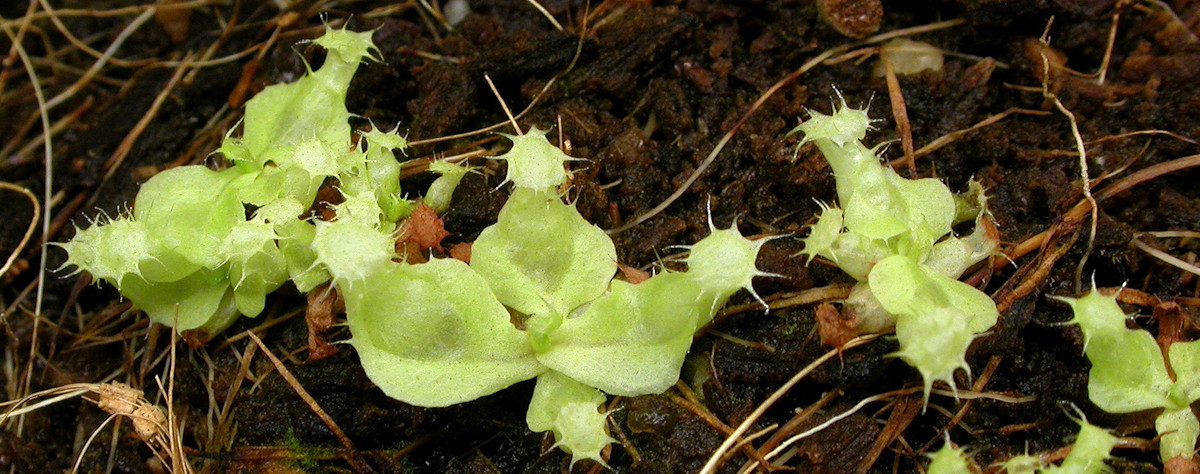
Nepenthes hybrid seedlings.
Nepenthes are found in diverse habitats from Madagascar and India to northern Australia, New Caledonia, and the Philippines. The areas with the most species in the most diverse habitats are Borneo, Sumatra, and Malaysia. They are found on beaches, in hot steamy jungles, and cold wind-swept ridge tops. Different species grow in sand, acid bogs, or alkaline volcanic soils. Some species like intense sun while others are at home in dense shade.
With over 100 species from so many habitats and many cultivars and hybrids providing even more diversity, there should be some Nepenthes that will grow well for you. Nepenthes species and hybrids with thick waxy leaves make great house plants if you have a window in your home that gets some direct sun. The easiest to grow are complex hybrids such as N. x Superba and N. x Mixta that were selected for being vigorous. It is hard to get them commercially so you may need to get cuttings from friends. Getting hybrid seed is usually easier (or less difficult) and should produce some nice plants. Growing your own from seed is lots of fun but remember it can take 3 to 5 years to get a plant from seed you can display.
Growing Nepenthes from seed can be quite challenging. It is recommended that beginners start with inexpensive tissue culture plants or plants from stem cuttings until you get experience with Nepenthes. When you can keep them alive and healthy for a few years, you might want to then think about growing Nepenthes from seed. The instructions below are for "typical" lowland and hybrid Nepenthes that are relatively easy to grow.
To get seeds, other than from friends or the Seed Bank, you need a male and a female plant in bloom at the same time. If you are interested in seeds of a species and do not want to make a hybrid that means you need a male plant and a female plant of the same species and they have to bloom at the same time. This is tough. When you get plants it is rare for them to be labeled as to sex. Most non-hybrid seeds in the Seed Bank are either from someone with a huge collection or are wild collected. The usual situation when you have a plant of each sex blooming at the same time is they are of different species. As far as is known all Nepenthes species will interbreed and that is one reason why there are so many hybrids. To tell male flowers from female, look for pollen on the stamen tip to confirm a fertile male and a bulge below the sepals to confirm a female. Use a paint brush to transfer the pollen. In the wild Nepenthes are fly pollinated and the flowers smell like it. It isn't a smell you generally want in your house but will not usually stink up more than a corner of a room.
Nepenthes seeds are ephemeral and vulnerable to freezing. When you get the seeds, plant them IMMEDIATELY. If you have extra, send them to the Seed Bank IMMEDIATELY unless there is a chance the seeds could be frozen en route. About half the Nepenthes seeds received by the Seed Bank are dead on arrival. Sometimes that is because they were probably frozen en route—it seems many seeds become available in late fall and early winter. The usual problem is they were sent after sitting around too long. Do not test germinate the seeds before sending them to the Seed Bank. They may germinate for you but be dead by the time they get to members. The Seed Bank does not test germinate the seeds either for the same reason.
Nepenthes seeds can be started on chopped live sphagnum moss in very damp but not wet conditions. If the sphagnum starts to overgrow the seeds, pinch it back with a forceps. If you use dried long fibered sphagnum instead, you may re-hydrate it with boiling water to reduce contaminants somewhat. If you cook it too much, the moss breaks down and molds very easily when it is eventually contaminated. Another option that works very well is to use coir, also called coco peat. Make sure you get a brand that says something like the coir "is exposed to rain water from at least three monsoon seasons" on the label. I especially like coir that has a 50% to 75% content of long fibers. I am not sure it is available any more. An option would be to add washed perlite to the coir.
Sprinkle the seeds onto the surface of the medium, spray with pure water, and place the pots in plastic bags in warm temperatures, about 26°C to 32°C (80°F to 90°F). Plastic bags will keep the humidity high and will exclude fungus gnats and spores of mold and moss. The pots should be in light shade or under fluorescent lights. Germination can take from 4 weeks to almost a year. The fresher the seed, the stronger the seedlings and higher the germination rate. Please see Sowing Seeds Step-by-Step for more details on starting seeds.
Keep an eye on the seeds since mold can be a problem. Generally, if the seeds are viable, have been stored well, and the medium you use is inert, you will not have problems with mold. If you do see mold, spray the seeds with pure water. It is probably a good idea to do this anyway to encourage germination.
The seedlings can remain in the original pots in plastic bags under lights for one to two years. If the soil surface gets nasty with cyanobacteria or moss or the small plants are too close together, carefully transplant to new media, in new pots, in new plastic bags, and put them back under the lights.
Something I do is after six months, if the seedlings are not bright green, I put high nitrogen (19-6-12) Osmocote™ pellets about 1 cm into the soil spaced about 2 to 3 cm apart—I put 4 pellets in an 8 cm square pot. The seedlings usually green up nicely and grow like crazy.
When the plants get large enough you can put a piece of dried blood worm (a kind of fish food) into the pitchers. Only do one or two at first to make sure it works under your conditions.
After about two years the seedlings can be repotted, spaced apart, and put into a terrarium or greenhouse. After they are established in the pots and you can see water in the bottom of the pitcher, and the pitchers are big enough (what is big enough?), you can try putting Osmocote™ pellets into the pitchers. Select the smallest pellets and put one pellet per plant and probably only one plant at first. If nothing bad happens after a few weeks, try a pitcher on other plants.
It will seem like forever, but after three to five years of care you could have more Nepenthes plants than you could ever want. Give the extra plants to friends. They will probably kill them. This time. But who knows, they might get hooked, and you can trade plants some day.
John Brittnacher
For more information please see:
Sacilotto, Robert (2004) Experiments with highland Nepenthes seedlings: A Summary of Measured Tolerances. Carniv. Pl. Newslett. 33(1):26-31 ( PDF )
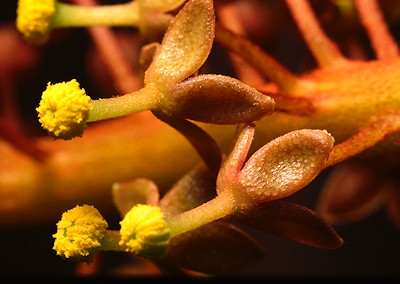
Nepenthes ventricosa male flowers. Photo by Mach Fukada.
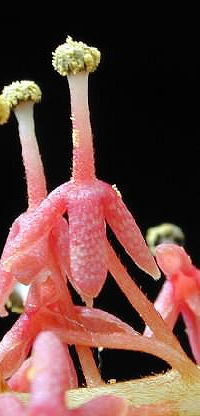
Close up of male Nepenthes ventricosa flowers.
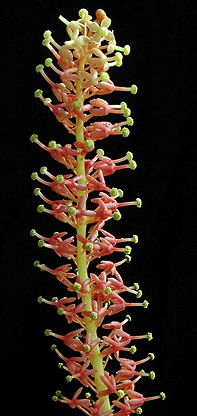
Male inflorescence.
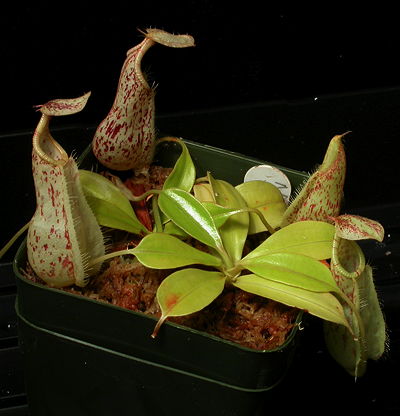
Three year old Nepenthes rafflesiana from seed
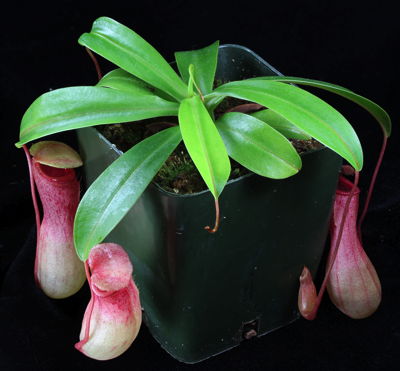
Two year old Nepenthes ventricosa from seed.

Nepenthes truncata sprouts in coir. Note the ungerminated seeds.
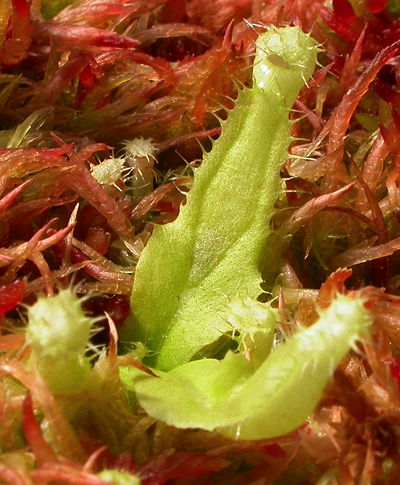
N. rafflesiana sprouts in live sphagnum.

One year old Nepenthes rafflesiana seedlings in live sphagnum.
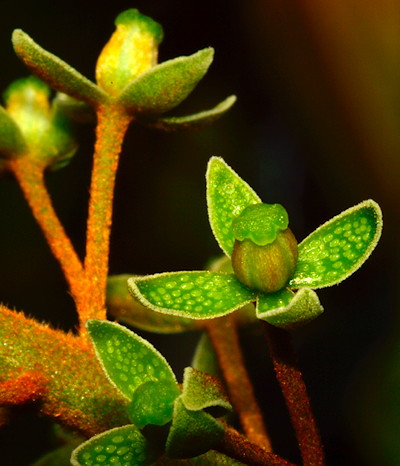
Nepenthes maxima female flowers. Photo by Mach Fukada.
